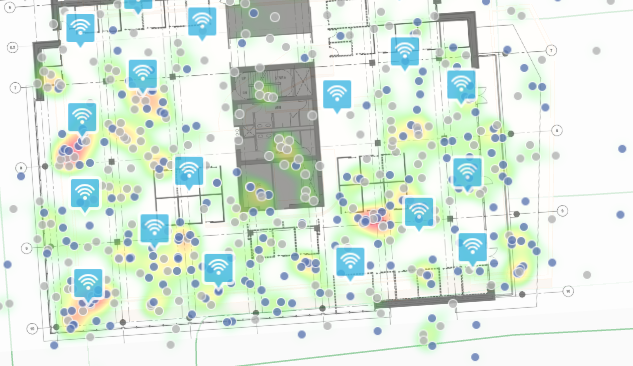WiFi analytics has emerged as a pivotal tool across various industries, such as hospitality and retail, changing the way businesses understand and engage with consumers.
By leveraging data collected from WiFi networks, companies gain deep insights into customer behaviour, preferences, and trends. This shift towards data-driven strategies enhances customer experiences and engagement, allowing businesses to tailor their services and marketing efforts more effectively.
As industries increasingly prioritise data to inform decisions, WiFi analytics offer a competitive edge in understanding and meeting consumer needs.
What is WiFi Analytics?
WiFi analytics involves analysing data collected from WiFi networks to understand customer behaviours and patterns.
It works by tracking devices that connect to or are detected by the WiFi network, allowing businesses to collect both authorised data (from users who log into the network) and unauthorised or presence data (from devices that are detected but not logged in). This information is crucial for businesses as it provides insights into customer demographics, dwell times, frequency of visits, and more, enabling more informed decisions regarding store layouts, marketing strategies, and customer engagement initiatives.

WiFi Presence Analytics
WiFi Presence Analytics utilises location-based data from physical spaces to analyse foot traffic, create heatmaps, and estimate crowd sizes. It also examines behavioural aspects such as the patterns of new versus returning visitors, the length of time spent in the area (dwell times), and the movement patterns within the space. This data is invaluable for businesses in understanding customer behavior and optimising the physical layout and service offerings to enhance the customer experience.
WiFi Marketing Analytics
WiFi Marketing Analytics focuses on collecting demographic information such as customer names, ages, birthdays, genders, and hometowns, along with digital marketing data like email addresses and social media profiles. This enables businesses to tailor their marketing efforts with a high degree of personalisation, improving engagement and effectiveness.
How Businesses Use WiFi Analytics to Optimise Operations, Marketing Strategies, and Customer Service
In the hospitality sector, WiFi analytics has revolutionised guest experiences. For example, hotels and resorts analyse guest movement to identify popular areas and adjust services accordingly, such as optimising staffing or enhancing amenities in high-traffic zones.
In retail, businesses utilise WiFi data to track shopper movements, identifying high-interest areas and optimising product placements to boost sales.
In event management, organisers use WiFi analytics to manage crowd flow and improve safety and satisfaction. Across these industries, the insights gained from WiFi analytics are pivotal in refining operational strategies, personalising marketing efforts, and elevating overall customer service, showcasing its versatile application and significant impact.
WiFi Analytics Tools and Technologies

WiFi analytics platforms come in various forms, ranging from basic apps that monitor network health to sophisticated systems capable of deep customer behavior analysis. For example, apps such as Netgear's WiFi Analytics tool are useful for assessing WiFi signal strength across different areas, helping businesses to get some basic insight into their network's coverage and performance. However, they won't give you anywhere near the same level of analysis as you would be able to get from conducting a professional WiFi survey or assessment.
Beyond signal optimisation, more advanced WiFi analytics solutions provide a granular view of customer interactions within a physical space. WiFi solutions from providers such as Cisco Meraki and Aruba Networks offer features that include real-time location heatmaps, user engagement metrics, and integration with CRM systems. These features allow businesses to not only understand how customers navigate their physical premises but also how to engage with them more effectively through personalised marketing and communication strategies.
The technical setup for implementing WiFi analytics involves several key steps, starting with the installation of WiFi access points capable of collecting data. This is followed by configuring the analytics software to capture and interpret data points relevant to the business's specific goals, such as foot traffic patterns, dwell times, and repeat visit rates. Data privacy and security are paramount, requiring businesses to ensure that their WiFi analytics practices comply with regulations like GDPR in Europe, which dictate how consumer data must be handled and protected.
The integration of WiFi analytics with other digital tools can amplify its benefits. For example, linking WiFi analytics data with online behavior analytics can provide a comprehensive view of the customer journey, bridging the gap between online and offline interactions. This holistic approach enables businesses to tailor experiences that resonate more deeply with their customers, driving loyalty and revenue.
The deployment of WiFi analytics tools involves a blend of technical setup, strategic data analysis, and adherence to privacy standards, all aimed at enhancing customer understanding and engagement. With the right tools and technologies, businesses can unlock valuable insights into consumer behavior, leading to more informed decision-making and optimised customer experiences.
WiFi Analytics Compliance
Adhering to data protection regulations is crucial when collecting and utilising WiFi analytics data to ensure customer privacy and ethical data use. Businesses must be transparent about data collection methods and purposes, obtain consent where necessary, and implement strong data security measures. Best practices include anonymising data, providing opt-out options, and regularly reviewing data handling policies to align with evolving legal standards and ethical expectations.
The Future of WiFi Analytics
WiFi analytics is evolving, driven by advancements in machine learning, artificial intelligence, and the Internet of Things (IoT).
These technologies are enhancing the capacity for predictive analytics, enabling businesses to anticipate customer needs and behaviors with greater accuracy.
Personalisation is reaching new heights, allowing companies to offer highly tailored experiences to their customers. Integration with IoT devices opens up a plethora of new data sources, providing deeper insights into customer interactions in physical spaces.
To stay competitive, businesses must embrace these innovative practices, constantly update their analytics capabilities, and leverage the rich data insights to refine customer engagement strategies.
This proactive approach will not only enhance customer experiences but also drive operational efficiencies and business growth. Adopting these future-forward practices in WiFi analytics will position businesses to better meet the evolving demands of their customers and the marketplace.






